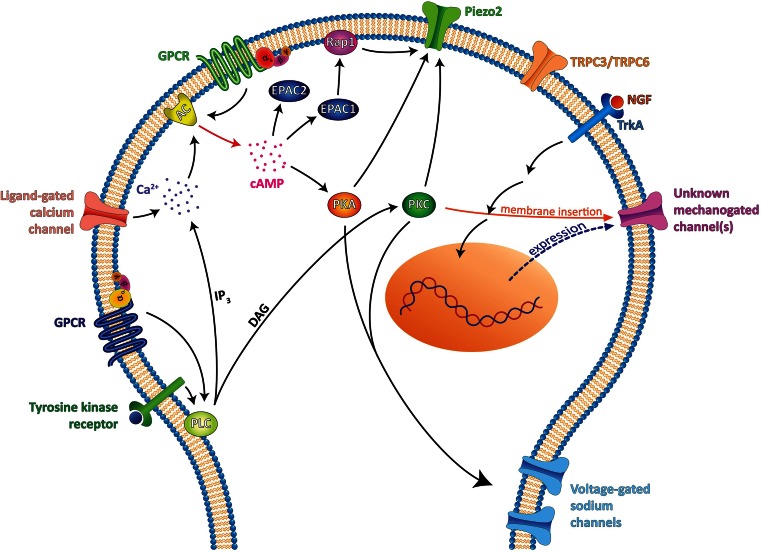Fig. 2.
Signalling pathways for the sensitization of mechanosensitive sensory neurons. Different but interconnected pathways have been shown to contribute to the sensitization of mechanosensitive neurons, leading to allodynia. PKA and PKC are known to be important for neuronal excitability, notably through voltage-gated sodium channel modulation [12, 39], but more recently, they were also found to have an effect on mechanotransduction directly. Indeed, the low threshold mechano-gated channel Piezo2 has been shown to be positively modulated by PKC, PKA [9] and by the cAMP sensor EPAC1 [10]. EPAC1, but not EPAC2, enhances Piezo2 current by activating the G protein Rap1 when activated by cAMP. cAMP increases can be induced directly by the activation of GPCR coupled to Gs proteins (PGE2 receptor EP2, histamine H2 receptor, CALCRL receptor for CGRP, serotonin receptor 5-HT4…) or indirectly via a calcium increase, induced either by an ion channel (TRPs, ASICs, P2Xs…) or by IP3-mediated calcium increase following either activation of a PLC coupled tyrosine kinase receptor (e.g. neurotrophin receptors) or activation of a GPCR coupled to Gq proteins (PGE2 receptor EP1, histamine receptor H1, serotonin receptor 5-HT2…). PLC activation will also result in DAG-mediated activation of PKC, which has also been shown to positively regulate Piezo2 channels [9]. However, PKA and PKC activation were found to have no effect on the human Piezo2 channel [10]. Therefore, further work is needed to clarify Piezo2 modulation by these signalling pathways. TRPC3 and TRPC6 channels were also found to be involved together in the generation of a low threshold mechanically activated current and to be essential for normal touch perception [34]. It is not known whether these channels are subject to the same positive regulation as Piezo2. Mechano-gated channels producing rapidly, intermediately and slowly adapting currents, yet to be identified, are also positively regulated by NGF and PKC [5]. In sensory neuron cultures, TrkA activation by NGF leads to transcription of new channels, and activated PKC promotes the insertion of the channels into the membrane to increase peak currents [2]

